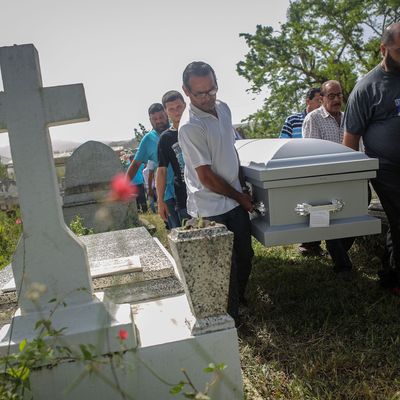
Hurricane Maria’s official death toll in Puerto Rico stands at 64 — but a new study from researchers at Harvard suggests that figure is off by at least 4,581.
Under the Centers for Disease Control and Prevention’s guidelines, a hurricane’s death toll comprises not only the number of lives lost to the storm’s immediate impact (as a result of flooding, flying debris, etc.), but also those lost as a result of shortages in material goods and medical services induced by the natural disaster. And it has long been obvious that the devastation wrought by Maria killed far more than 64 Puerto Ricans.
For weeks after the storm, most of Puerto Rico lacked electricity, including its hospitals. Respirators stopped running. Dialysis clinics operated on generators and for limited hours. Medical supplies were scarce. Meanwhile large stretches of the territory had only limited access to food and potable water. Temperatures were high. Puerto Rico’s population is disproportionately elderly, and its elderly population is disproportionately impoverished.
The government’s radical underestimate of Maria’s death toll is, in part, a product of bureaucratic red tape: The government’s Forensic Science Institute in San Juan must confirm each disaster-related death, which requires transporting bodies to San Juan or dispatching medical examiners to inspect dead bodies in rural municipalities. But even without this stringent requirement, the task of identifying those killed by the storm’s indirect effects would still be inherently difficult (like their fellow citizens in the mainland United States, plenty of Puerto Ricans were suffering preventable deaths due to insufficient access to medical care long before Maria made landfall).
To arrive at their new death toll estimate, researchers from the Harvard T.H. Chan School of Public Health and Beth Israel Deaconess Medical Center opted for a more abstractly statistical approach. After soliciting reports of recent deaths from 3,3000 randomly chosen Puerto Rican households, they found the island’s mortality rate in the three months after the hurricane was roughly 14.3 deaths per 1,000 residents — a figure 62 percent higher than it had been during the same period in 2016. From this finding, the researchers estimated that the island suffered 4,645 more deaths between September 20 and December 31, 2017, than it would have in the absence of the hurricane.
In its report on the study, the Washington Post provides a harrowing illustration of what such an “excess death” looks like:
Among those who died as a result of medical service lapses was Ivette Leon, 54, a Boy Scout den mother who died on Nov. 29, about 18 hours after she was released from the hospital in post-hurricane Puerto Rico. Leon had fallen ill, suffering from pain all over her body, vomiting and chills. Physicians told her it was an infection, gave her medication, and released her to her family.
Miliana Montanez cradled her mother’s head as she lay dying on the floor of her bedroom here in Caguas, gasping for air and pleading for help.
There was nothing her family could do. It took 20 minutes to find cell reception to make a 911 call. Nonworking traffic signals slowed down the ambulance struggling to reach their neighborhood through crippling congestion.
Leon’s eyes bulged in terror as she described to her daughter the tiny points of light that appeared before her eyes moments before it was all over.
Puerto Rico’s government is working with experts from George Washington University to produce a more credible, evidence-based estimate of the hurricane’s human costs. Their report is expected to be released in the coming weeks.
In a sense, Harvard’s tally likely overstates the number of Puerto Ricans killed by Hurricane Maria — but only because a significant fraction of the deaths it identifies are less attributable to the storm itself, than the inadequacy of the federal response.
Days before Hurricane Maria made landfall, the White House learned that a Category 4 storm was likely to hit the island, and that the territory’s electrical grid was unlikely to survive such an onslaught.
The federal government had time to deploy satellite phones to the island, to avoid the communications blackout that isolated remote areas from the territory’s government. It could have delivered reserves of food, fuel, and water in advance of the storm, allowing local officials to spread those vital resources throughout the territory before Maria lay waste to much of its trucking infrastructure. Instead, the president did almost nothing in the lead-up to the storm; went on a four-day golf vacation in its immediate aftermath; and proceeded to devote far more federal resources to hurricane relief efforts in Texas, than to those targeting the far more devastated Puerto Rico.






























